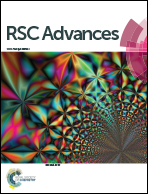An ultra-long and low junction-resistance Ag transparent electrode by electrospun nanofibers†
Abstract
Silver nanofibers (Ag NFs) have attracted considerable attention for their potential applications in transparent electrodes to replace indium tin oxide (ITO). One of the key factors for hindering the performance of transparent electrodes is the junction resistance between nanofibers. Here, we combine an electrospinning method and electroless deposition to fabricate a Ag NFs transparent conducting electrode (TCE). Ultra-long PVDF/SnCl2 nanofibers were firstly fabricated onto a flexible substrate as the template of Ag TCE. Subsequently, electroless deposition was adopted to deposit Ag onto the nanofiber template to decrease the junction resistance. The morphology and composition of the Ag NFs are systematically analyzed. The as-fabricated Ag TCE shows a conductivity of 73.55 Ω □−1 and 15.35 Ω □−1 (transmittance of 84% and 75%) and maintains its conductive properties even after 100 bending cycles. Importantly, the figure of merit Φ = T10/Rs, Ω □−1, commonly used to evaluate the performance of transparent conducting electrodes, calculated for our Ag NF TCE is 2.3 × 10−3 Ω □−1 (T ∼ 84%, Rs ∼ 73.55 Ω □−1). This value is much higher than that of other transparent electrodes, such as SWCNT (∼0.8 × 10−3 Ω □−1), graphene (∼0.3 × 10−3 Ω □−1), Ni film (∼0.7 × 10−3 Ω □−1). In addition, this Ag NFs transparent electrode is fabricated under ambient temperature and applicable to various substrates. Our results present a facile method for fabricating a TCE with relatively low Ag materials cost and reducing the junction resistance between nanofibers.


 Please wait while we load your content...
Please wait while we load your content...